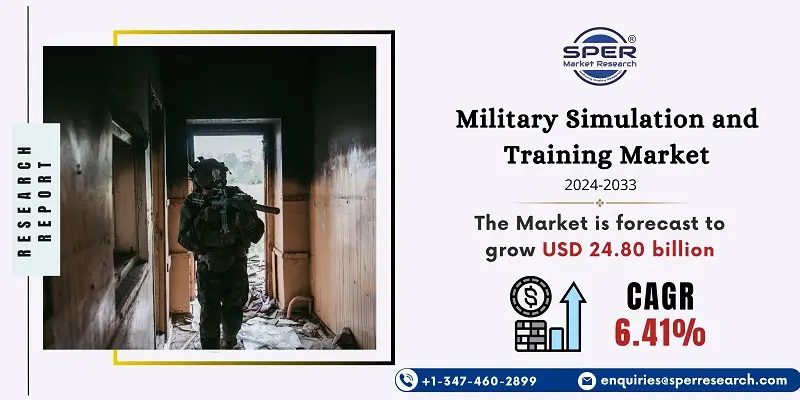
Military Simulation and Training Market Growth, Size, Trends, Share, Revenue and Future Outlook
Military Simulation and Training Market Size- By Type, By Application, By Platform, By Environment- Regional Outlook, Competitive Strategies and Segment Forecast to 2033
| Published: Jun-2024 | Report ID: AERO2419 | Pages: 1 - 219 | Formats*: |
| Category : Aerospace and Defence | |||
- July 2022: Simulators for the NH 90 NFH Sea naval helicopters were introduced by the RHEINMETALL. Furthermore, these simulators enable the Bundeswehr's Naval Air Squadron 5 to carry out real-world maintenance and repair duties.
- August 2022: An agreement was inked by Northrop Grumman and Terma to work together on training and simulation opportunities related to electronic warfare in Northern Europe. The company's simulation and training capabilities will enable realistic air combat training for fourth and fifth generation aircraft.


| Report Metric | Details |
| Market size available for years | 2020-2033 |
| Base year considered | 2023 |
| Forecast period | 2024-2033 |
| Segments covered | By Type, By Application, By Platform, By Environment |
| Regions covered | North America, Asia-Pacific, Latin America, Middle East & Africa and Europe |
| Companies Covered | Lockheed Martin, Northrop Gumman, L3Harris Technologies, Raytheon Technologies, Rheinmetall AG, BAE Systems, Others. |
- Defence Ministers and Military Organisations
- Defence Contractors and Manufacturers
- Technology Firms
- Government Agencies
- Research and Development Organizations
- Research and consulting firms
| By Type: |
|
| By Application: |
|
| By Platform: |
|
| By Environment: |
|
- Military Simulation and Training Market Size (FY’2024-FY’2033)
- Overview of Military Simulation and Training Market
- Segmentation of Military Simulation and Training Market By Type (Live, Virtual, Constructive)
- Segmentation of Military Simulation and Training Market By Application (Army, Aviation, Naval)
- Segmentation of Military Simulation and Training Market By Platform (Land, Maritime, Airborne)
- Segmentation of Military Simulation and Training Market By Environment (Synthetic, Gaming)
- Statistical Snap of Military Simulation and Training Market
- Expansion Analysis of Military Simulation and Training Market
- Problems and Obstacles in Military Simulation and Training Market
- Competitive Landscape in the Military Simulation and Training Market
- Impact of COVID-19 and Demonetization on Military Simulation and Training Market
- Details on Current Investment in Military Simulation and Training Market
- Competitive Analysis of Military Simulation and Training Market
- Prominent Players in the Military Simulation and Training Market
- SWOT Analysis of Military Simulation and Training Market
- Military Simulation and Training Market Future Outlook and Projections (FY’2024-FY’2033)
- Recommendations from Analyst
1.1. Scope of the report1.2. Market segment analysis
2.1. Research data source
2.1.1. Secondary Data2.1.2. Primary Data2.1.3. SPER’s internal database2.1.4. Premium insight from KOL’s
2.2. Market size estimation
2.2.1. Top-down and Bottom-up approach
2.3. Data triangulation
4.1. Driver, Restraint, Opportunity and Challenges analysis
4.1.1. Drivers4.1.2. Restraints4.1.3. Opportunities4.1.4. Challenges
4.2. COVID-19 Impacts of the Military Simulation and Training Market.
5.1. SWOT Analysis
5.1.1. Strengths5.1.2. Weaknesses5.1.3. Opportunities5.1.4. Threats
5.2. PESTEL Analysis
5.2.1. Political Landscape5.2.2. Economic Landscape5.2.3. Social Landscape5.2.4. Technological Landscape5.2.5. Environmental Landscape5.2.6. Legal Landscape
5.3. PORTER’s Five Forces
5.3.1. Bargaining power of suppliers5.3.2. Bargaining power of buyers5.3.3. Threat of Substitute5.3.4. Threat of new entrant5.3.5. Competitive rivalry
5.4. Heat Map Analysis
6.1. Military Simulation and Training Market Manufacturing Base Distribution, Sales Area, Product Type6.2. Mergers & Acquisitions, Partnerships, Product Launch, and Collaboration in Military Simulation and Training Market
7.1. Military Simulation and Training Market Size, Share and Forecast, By Type, 2020-20267.2. Military Simulation and Training Market Size, Share and Forecast, By Type, 2027-20337.3. Live7.4. Virtual7.5. Constructive
8.1. Military Simulation and Training Market Size, Share and Forecast, By Application, 2020-20268.2. Military Simulation and Training Market Size, Share and Forecast, By Application, 2027-20338.3. Army8.4. Aviation8.5. Naval
9.1. Military Simulation and Training Market Size, Share and Forecast, By Platform, 2020-20269.2. Military Simulation and Training Market Size, Share and Forecast, By Platform, 2027-20339.3. Land9.4. Maritime9.5. Airborne
10.1. Military Simulation and Training Market Size, Share and Forecast, By Environment, 2020-202610.2. Military Simulation and Training Market Size, Share and Forecast, By Environment, 2027-203310.3. Synthetic10.4. Gaming
11.1. Military Simulation and Training Market Size and Market Share
12.1. Military Simulation and Training Market Size and Market Share By Region (2020-2026)12.2. Military Simulation and Training Market Size and Market Share By Region (2027-2033)12.3. Asia-Pacific
12.3.1. Australia12.3.2. China12.3.3. India12.3.4. Japan12.3.5. South Korea12.3.6. Rest of Asia-Pacific
12.4. Europe
12.4.1. France12.4.2. Germany12.4.3. Italy12.4.4. Spain12.4.5. United Kingdom12.4.6. Rest of Europe
12.5. Middle East and Africa
12.5.1. Kingdom of Saudi Arabia12.5.2. United Arab Emirates12.5.3. Qatar12.5.4. South Africa12.5.5. Egypt12.5.6. Morocco12.5.7. Nigeria12.5.8. Rest of Middle-East and Africa
12.6. North America
12.6.1. Canada12.6.2. Mexico12.6.3. United States
12.7. Latin America
12.7.1. Argentina12.7.2. Brazil12.7.3. Rest of Latin America
13.1. Lockheed Martin
13.1.1. Company details13.1.2. Financial outlook13.1.3. Product summary13.1.4. Recent developments
13.2. Northrop Gumman
13.2.1. Company details13.2.2. Financial outlook13.2.3. Product summary13.2.4. Recent developments
13.3. L3Harris Technologies
13.3.1. Company details13.3.2. Financial outlook13.3.3. Product summary13.3.4. Recent developments
13.4. Raytheon Technologies
13.4.1. Company details13.4.2. Financial outlook13.4.3. Product summary13.4.4. Recent developments
13.5. Rheinmetall AG
13.5.1. Company details13.5.2. Financial outlook13.5.3. Product summary13.5.4. Recent developments
13.6. BAE Systems
13.6.1. Company details13.6.2. Financial outlook13.6.3. Product summary13.6.4. Recent developments
13.7. Others
SPER Market Research’s methodology uses great emphasis on primary research to ensure that the market intelligence insights are up to date, reliable and accurate. Primary interviews are done with players involved in each phase of a supply chain to analyze the market forecasting. The secondary research method is used to help you fully understand how the future markets and the spending patterns look likes.
The report is based on in-depth qualitative and quantitative analysis of the Product Market. The quantitative analysis involves the application of various projection and sampling techniques. The qualitative analysis involves primary interviews, surveys, and vendor briefings. The data gathered as a result of these processes are validated through experts opinion. Our research methodology entails an ideal mixture of primary and secondary initiatives.



Frequently Asked Questions About This Report
PLACE AN ORDER
Year End Discount
Sample Report
Pre-Purchase Inquiry
NEED CUSTOMIZATION?
Request CustomizationCALL OR EMAIL US
100% Secure Payment






Related Reports
Our Global Clients
Our data-driven insights have influenced the strategy of 200+ reputed companies across the globe.




















